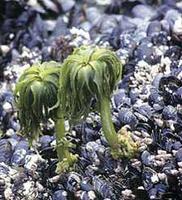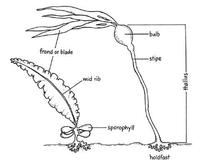Seaweed
SEAWEED (benthic marine algae) is a large photosynthetic organism typically attached to rocks in the intertidal or shallow subtidal zones to depths of 30–40 m. Approximately 700 species are found on the Pacific coast from Alaska to California, in 3 phyla commonly referred to as green, red and brown seaweeds (see also SEAGRASSES). Seaweeds are the largest types of algae. They contain chlorophyll and other pigments that utilize sunlight to manufacture nutrients by photosynthesis. They are generally simpler than land plants: they do not have roots or conducting systems because all parts of the plant obtain nutrients and dissolved gases for growth and reproduction directly from the surrounding water. They are anchored, or attached, by a holdfast. The stem-like portion (stipe) supports the leaf-like or blade-like structures, which are the main sites of photosynthesis and reproduction.
Brown seaweeds (phylum Phaeophyta), which include bull KELP and giant kelp, are the largest in BC. Rockweed, or bladderwrack (Fucus evanescens), is commonly found intertidally. Yellow-green to brown in colour, it is recognizable by flattened branchlets with swollen, warty ends containing the gametes. These ends pop when stepped on or pressed between fingers. Another common brown seaweed is Japanese weed (Sargassum muticum), a long, soft, matted weed whose many branches are lined with small bladder-like floats. This species was introduced accidentally to the coast from Japan on the shells of OYSTER seed.
Green seaweeds (phylum Chlorophyta) form a variety of lettuce-like and ropey or hair-like growths, mats and cushions. Red seaweeds are actually variable in colour from red to brown, purple to black, and also vary in shape from encrusting patches to large, conspicuous single or branched blades. Coral seaweeds belong to this group. The common brick-red to purple Turkish towel (Chondracanthus exasperatus) is often washed up on the beach. In 2001, SOOKE-based Outer Coast Seaweeds began harvesting several different edible species along the beaches of Vancouver I, which it sold to the beauty and spa market and to restaurants.


